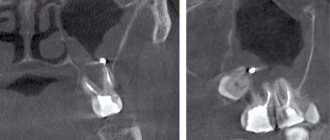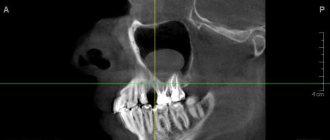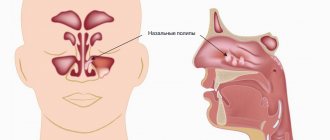1.General information
Erysipelas, erysipelas - these and similar terms are used mainly in Slavic languages; in medical Latin and most Western European languages, the original ancient Greek name erysipelas was fixed, i.e. "red skin" In the old days there were also synonyms “holy fire”, “Saint Anthony’s fire” or, in Russian, “Antonov’s fire”, although some dictionaries define this term as one of the designations for gangrene.
Erysipelas is an acute skin infection (or recurrent exacerbation of a chronic one), the hallmarks of which are swelling and erythema - a bright red, “fiery” hue of the affected area. In general, erysipelas is one of the most common human infectious diseases; the localization of inflammation can be very different, however, due to the peculiarities of the anatomical structure, the disease often manifests itself on the skin of the face, primarily in the soft tissues of the external nose (vestibule, wings, nasal walls): a high concentration of sebaceous glands, capillaries and nerve endings facilitates the penetration and activation of the pathogen .
A must read! Help with treatment and hospitalization!
Why does swelling of the eyes and face develop with sinusitis?
Initially, swelling with sinusitis occurs in the sinuses.
At the same time, experts argue that this is not only a consequence of the development of inflammation, but also an additional protection of the body from pathogenic microorganisms entering the body through the nose (swelling narrows the maxillary sinuses and acts as an additional barrier).
Know! It is useless to eliminate the swelling itself during sinusitis, and if the root causes of the pathology are not identified in time and treatment is not started, the inflammatory processes continue to spread and spread to the face in the eye area.
The reason for the development of such swelling may be :
2. Reasons
Erysipelas is a bacterial infection, the causative agent of which is almost always group A beta-hemolytic streptococci. This tendency, however, is not absolute: a similar inflammation can be caused by staphylococcus, especially in cases of a long-term chronically recurrent process, as well as other pathogens. In general, we have to take into account the fact that in recent decades in the clinic of infectious diseases, incl. skin, there is a steady tendency towards an increase in combined invasions (for example, bacterial and fungal), developing according to the mechanism of super- or coinfection.
The main risk factor is microtraumatization of the skin of the nose in combination with weakened local immunity and non-compliance with sanitary and hygienic rules.
The risk increases in the presence of foci of chronic coccal infection in adjacent tissues and organs (otitis, tonsillitis, sinusitis, and many others). One of the widespread causes of erysipelas is the practice of self-squeezing out elements of acne and/or pustular (pustular) rash in unsterile or frankly unsanitary conditions. In some cases, nasal erysipelas is iatrogenic in nature, i.e. the launch of the pathological process is caused by medical procedures or surgical intervention on the ENT organs.
Visit our Otolaryngology (ENT) page
Treatment
Pre-hospital assistance
Patients with a tendency to develop swelling of the nasal mucosa are advised to refrain from contact with strong-smelling substances, install an air humidifier, wear a hat in winter, and avoid swimming in cold ponds and pools. Patients with allergic reactions should, if possible, avoid contact with allergens and, if necessary, take antiallergic medications. For short-term swelling, you can use vasoconstrictors yourself. In case of persistent swelling, you need to consult a specialist.
Conservative therapy
For the treatment of diseases accompanied by swelling of the nasal cavity, the following methods are recommended:
- Adrenergic agonists
. To ease breathing, they are prescribed in the form of drops and used for 1 or 2 weeks. Long-term use is undesirable, as it can lead to the development of vasomotor rhinitis. - Antiallergic drugs
. Mast cell membrane stabilizers and antihistamines can quickly reduce swelling, improve nasal breathing, and eliminate other allergy symptoms. - Glucocorticosteroids
. Nasal sprays with hormones reduce swelling, reduce the amount of discharge, and reduce the sensitivity of the mucous membrane to irritants. Prescribed for vasomotor and allergic rhinitis, nasal polyps. - Antibiotics
. Effective for inflammatory otolaryngological diseases: chronic rhinitis, frontal sinusitis, sinusitis. At the initial stage, broad-spectrum medications are administered, then antibiotic therapy is adjusted taking into account the sensitivity of the pathogen. - Physiotherapy
. Drug electrophoresis, microwave therapy, darsonvalization, and some other techniques are used.
Surgery
If indicated, surgical interventions are performed for the following diseases and conditions:
- Hypertrophic rhinitis: conchotomy.
- Deviated nasal septum: septoplasty, rhinoseptoplasty.
- Sinusitis: maxillary sinusotomy or frontotomy.
- Volume formations: removal of polyps and tumors.
Some operations are performed not only openly, but also endoscopically, which makes it possible to reduce the traumatic nature of manipulations and shorten the rehabilitation period. It is possible to use various energies: laser, radio wave radiation, etc.
3. Symptoms and diagnosis
As shown above, typical manifestations of erysipelas of the nose include erythema and inflammatory swelling of the soft tissues, clearly demarcated by a roller from healthy skin. The swelling can be so severe that the patient’s face becomes deformed and changes beyond recognition. Blisters filled with mucopurulent exudate (bullous form of erysipelas) are often observed.
As a rule, the general symptoms of infectious intoxication are pronounced: malaise, fever, hyperthermia (up to 40° and above), headache, weakness, soreness and swelling of the nearest lymph nodes. After a few days, body temperature may drop just as sharply.
It should be noted that in the absence of timely adequate therapy, erysipelas tends to expand to neighboring areas (skin of the face, neck, chest, ear, etc.); with the involvement of the mucous membranes and submucosal layers of the pharyngeal structures, the development of such serious complications as abscess formation, phlegmon, sepsis, and intracranial inflammation is possible.
The clinical picture of erysipelas is quite specific and usually does not create any difficulties in diagnosis. Examination of the ENT organs reveals hyperemia of the mucous membranes of the nasal cavity. Laboratory diagnostic methods are used to identify the pathogen(s) and assess drug sensitivity. In more complex cases, they resort to instrumental imaging diagnostics (endoscopy, ultrasound, etc.).
About our clinic Chistye Prudy metro station Medintercom page!
Types of tumors of the nasal cavity and paranasal sinuses
Contents
hide
1 Types of tumors of the nasal cavity and paranasal sinuses
2 Causes 2.1 Symptoms 2.1.1 Diagnostic methods 2.1.1.1 Treatment methods
If the conclusion is “tumor”, the first thing that worries the patient is whether it is benign or malignant. The prognosis and method of treatment will depend on this factor.
Benign formations formed in the nasal cavity, paranasal sinuses and nasopharynx are divided according to location:
- on soft parts (hemangiomas vascular formations, myxoma, angiofibroma and many other varieties);
- on hard parts;
- mixed (teratoma, meningioma, etc.);
- tumor-like formations (polyps, cavities with fluids, hyperplasia, papillomas).
More often than others, hemangioma develops. It can appear at any stage of life with equal frequency in men and women. Hemangioma usually forms in the anterior part of the nasal septum - where the bones and cartilage meet. It looks like a bright red polyp, often bleeding due to the passage of many capillaries through it.
Malignant tumors of the nose and paranasal sinuses account for approximately 3% of all cancers. If we consider ENT tumors, the first place in frequency will be neoplasms of the larynx and laryngopharynx, and in second place will be the nose and adjacent areas. The maxillary sinus and nasal cavity are most often affected. Men suffer from this disease twice as often as women. Representatives of the stronger sex are at risk.
Cancerous tumors that affect the nose develop quickly, reaching the orbit and eye, the base of the skull, and sometimes its cavity. Squamous cell oncology leads in frequency (more than half). The growth in this case arises from the epithelium. In addition, the nose can become a place for the development of melanoma (a neoplasm developing from pigment), sarcoma (from connective tissue), and adenocarcinoma.
Inverted papilloma occupies a special place. This is a benign neoplasm of the paranasal region with a high risk of becoming malignant, which happens with poor quality treatment.
Why does it occur
A possible cause of nasal swelling is an allergic reaction to pollen.
- How to relieve swelling of the nasal mucosa: treatment and recovery
Let's look at what are the causes of swelling of the nose and nasopharynx.
- An allergic reaction is a fairly common provocateur for the development of swelling. Allergies can be triggered by plant pollen, dust, animal hair, bird feathers and other allergens. If we consider an infant toddler, he may experience a reaction to foods, formula, or food consumed by a nursing mother.
- Physiological runny nose is a possible cause of swelling in newborns. The whole problem is that the baby, while in the mother’s womb, does not use the nose in the process of breathing; the mucous membrane of the nose is not ready to cope with its function in full.
- Infection. Swelling of the nose, as well as a runny nose, may indicate the presence of viruses or bacteria that have infected the mucous membrane.
- The presence of a polyp, hypertrophied mucous membrane that protrudes. Hypertrophy occurs due to frequent exposure to allergens or infections, as well as due to anatomical features. You need to know that a polyp does not develop overnight, it takes a long period of time, and the symptoms will worsen as the polyp grows.
- Adenoids are a proliferation of lymphoid tissue.
- Swelling of the nose without a runny nose is observed due to injury.
Prevention methods
Timely prevention is the main condition for maintaining the health of the kidneys, heart and other organs at any age. Doctors have several recommendations on how to avoid swelling:
- choose foods with a minimum amount of salt, spices and sugar, avoid fatty and fried foods;
- give up bad habits - smoking and drinking alcoholic beverages;
- do not overeat before going to bed and do not drink a lot of liquid;
- undergo regular thyroid examinations and donate blood tests;
- choose orthopedic pillows and a sleeping mattress that will not impair cerebral circulation;
- prevent excess weight;
- Do simple physical exercises in the fresh air every day.
The Clinical Brain Institute offers individual programs for the diagnosis and treatment of various diseases that are accompanied by swelling in the face and headaches. Our center has precise, modern equipment that allows you to quickly assess the condition of internal organs and perform the necessary tests in the laboratory. Doctors are experienced specialists in a narrow and broad profile. They will prescribe a competent treatment regimen, but its effectiveness will depend, among other things, on following all recommendations at home.
Anatomy of the external nose
The external nose has a complex anatomy, being an organ with a cartilaginous and bony skeleton, covered with thick skin. It consists of the following sections: the root (the area between the brow ridges), tapering downwards and turning into the pyramid - part of the bony skeleton of the nose, represented by the nasal bones and the frontal processes of the upper jaw.
In the pyramid, there is a back - a face facing outwards, and slopes - the side surfaces of the pyramid. The tip of the nose is the most protruding part, represented by a cartilaginous skeleton. The tip consists of several cartilages: large and small alar cartilages, lateral cartilages (also called triangular) and quadrangular septal cartilage. All these cartilages are paired, with the exception of the quadrangular one. The cartilaginous section also includes: the wings of the nose, which form the respiratory openings, the nostrils and the collumella - the fold of skin between the nostrils.
The wings of the nose are covered from the inside with skin overgrown with dense bristly hairs; they form the vestibule of the nasal cavity, which passes into the cavity itself. The skin of the tip is very tightly fused with the underlying cartilage; in the bony part, the skin lies on loose subcutaneous tissue and is easily displaced. Between the skin and cartilage there are facial muscles, thanks to which we can wrinkle our nose, flare our wings, raise and lower the tip, which serves as a demonstration of emotions. The blood supply to the nose is very good. It comes from the system of external and internal carotid arteries. Venous outflow goes both to the internal jugular vein system and to the cranial cavity. Innervation is carried out by the branches of the trigeminal nerve.
What Causes Swelling
The mucous membrane of the nasal cavities contains a large number of blood vessels that provide warming to the inhaled air. The ciliated epithelium, namely its cilia, help retain particles of dust and dirt, and the nasal secretion helps prevent their penetration into the bronchi.
Inflammation that begins to develop in the nasopharynx due to the penetration of viruses, bacteria, and allergens, as a rule, causes swelling of the mucous membrane of this area and the organs of the visual system. Swelling in the nasal passages is characterized by difficulty breathing, frequent sneezing, and the production of mucous fluid.
Nasal swelling in newborns is caused not only by colds, but often occurs against the background of other provoking factors: teething, overheating, pathologies in the anatomical structure of the nasal passages. A common cause of edema is dry air in the living room.
Dry air is the main enemy
If the air in the room where the newborn lives is too dry, this often causes swelling. The nasal passages of a baby are narrower than, for example, those of a baby who has reached the age of one. In this regard, swelling of these can provoke pathology.
- Swelling of the nasal mucosa: causes, symptoms, treatment
During the cold season (for example, in winter), many parents try to heat the room by turning on air heaters, but these contribute to drying out the room. Nasal swelling caused by this factor occurs without a runny nose and, as a rule, appears in the morning after waking up.
Signs of a malignant process
The root cause of the development of nasal cancer has not been determined. There are risk factors that provoke the appearance of a tumor:
- Active (to a greater extent) and passive smoking.
- Work in hazardous industries: interaction with flour dust, wood, textiles, leather goods.
- Prolonged contact with radium, chrome and nickel dust, formaldehyde, solvents, and other chemical compounds.
- Chronic forms of various variants of sinusitis, rhinitis.
- Alcohol abuse.
- Long stay in a place with unfavorable ecology.
- Viral infection (for example, human papillomavirus).
When determining the stage of nasal cancer, experts pay attention to the following points:
- The spread of the process to other sinuses, soft tissues of the face, bone fragments.
- The presence or absence of metastases in regional lymph nodes - those closest to the diseased organ.
- The presence or absence of metastases distant from the lesion.
Diagnostic methods in Medscan
The examination begins with an examination and interview with an oncologist. At the Medscan Oncology Center, an interdisciplinary approach is taken to each case under consideration. This eliminates errors in making a final diagnosis and during further treatment.
After rhinoscopy (examination of the nose using special mirrors), you will need to perform the following techniques:
- Pharyngoscopy. The examination helps determine the extent of tumor growth in the oral cavity.
- Radiography. Using the method, you can find out tissue disorders, the degree of deformation and asymmetry of the face.
- MRI and CT are considered the most informative methods for visualizing a tumor focus. To better assess the extent of oncological pathology, the study is performed with intravenous contrast.
- Biopsy of a tumor fragment with further histological examination.
- Ultrasound of lymph nodes and abdominal organs.
What contributes to the formation of nasal swelling without a runny nose?
The development of nasal swelling without a runny nose in a child does not occur on its own. This condition is influenced by several factors, namely infectious or allergic:
- vasomotor rhinitis caused by infectious pathogens or allergic irritants (narrowing of the nasal passages occurs, congestion and runny nose);
- constant exposure to medications, which contributes to the development of chronic swelling without a runny nose.
In addition, the causes of dry rhinitis are polyps in the passages, a deviated septum, and dry air that the child breathes. The doctor will tell you what to do if your child has mucus due to swelling of the nose, but without snot.
Therapy in children
You can remove swelling in a child’s nose using a comprehensive method, using medications and other therapeutic procedures (for example, physiotherapy). Among the medications, vasoconstrictors are actively prescribed, for example, Naphthyzin or Galazolin. These products should only be used after consultation with your doctor.
A universal treatment for nasal swelling without a runny nose in a child has not been developed. Methods of getting rid of a symptom depend on the root cause of this condition: with an infectious etiology they are the same, and, for example, with an allergic etiology, they are different.
Main function of the nose
The main function of this organ is respiratory, but aesthetic and communication functions will also be important. Scientific studies have been conducted that have revealed that people recognize each other by the shape and size of the nose, as well as by its proportions relative to other parts of the face. Thus, it is one of the most important signs of objective individuality.
Different races have their own characteristics of the structure of the external nose:
- Slavic - a relatively small bone part and a more developed cartilaginous section;
- Greek or Roman - distinguished by a long, narrow pyramid of the nose, often with a hump and a relatively small cartilaginous section;
- Caucasian - large bone and cartilaginous part, often with a hump;
- negroid - characterized by a small bony part and a large, usually flattened tip with wide wings;
- Asian - distinguished by proportionally small bone and cartilaginous parts, often with a flattened back and tip.
One of the features of our olfactory organ is that it grows throughout our lives, changing with age. This is especially true for the nasolabial angle. In children, the nasolabial angle is usually obtuse, about 105 degrees; in adults, it approaches a rectangular angle; in older people, the tip often drops and the angle becomes acute.










